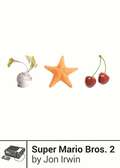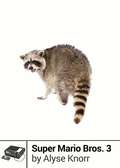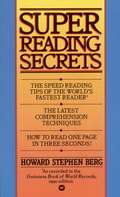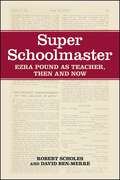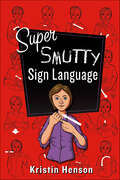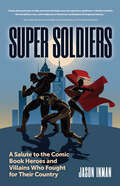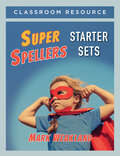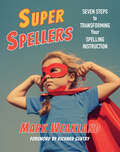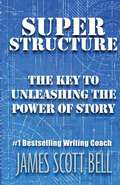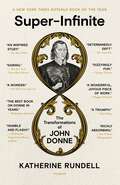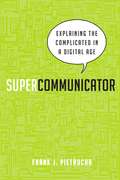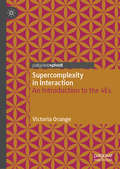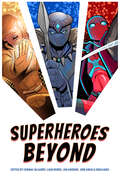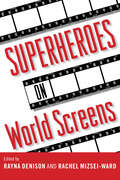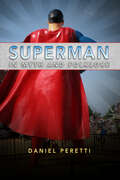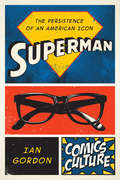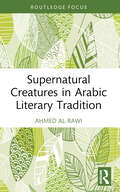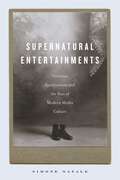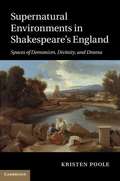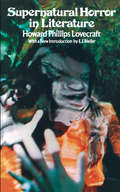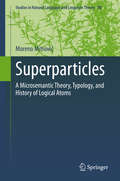- Table View
- List View
Super Mario Bros. 2 (Boss Fight Books)
by Jon IrwinIn perhaps the most famous switcheroo in all of game history, the Japanese version of Super Mario Bros. 2 was declared &“too hard&” by Nintendo of America and replaced with a Mario-ified port of the Famicom hit, Yume Kojo: Doki Doki Panic. The new game (dubbed Super Mario USA in Japan) was a huge success for its four playable characters, improved graphics, immersive levels, and catchy music, and eventually became the 3rd bestselling game for the NES. And yet. Because of its strange new villains, its wild gameplay, and its mysterious touches, SMB2 has for years been regarded as the Odd Mario Out, even as it has seen popular updates on the Super NES and Game Boy Advance. Irwin&’s Mario is not a simple retelling of a 25-year-old story, but instead an examination of the game with fresh eyes: both as a product of its time and as a welcome change from the larger Super Mario franchise. Along the way he searches for clues, pulling up a few vegetables of his own. What he finds is not at all what he expected.
Super Mario Bros. 3 (Boss Fight Books)
by Alyse KnorrUpon its 1990 NES release, Super Mario Bros. 3 flew in on the P-wings of critical raves, intense popular demand, and the most sophisticated marketing campaign Nintendo of America had ever attempted. Shigeru Miyamoto's ultimate 8-bit platformer lived up to all the hype and elevated Mario from mascot to icon. But what exactly made this game the phenomenon it was? With the help of her friends and family, critics inside and outside the realm of gaming, and former Nintendo of America employees, Alyse Knorr traverses the Mushroom World looking for answers. Along the way, Knorr unearths SMB3's connections to theater and Japanese folklore, investigates her own princess-rescuing impulses, and examines how the game's animal costumes, themed worlds, tight controls, goofy enemies, and memorable music cohere in a game that solidified Mario's conquest of the NES era.
Super Reading Secrets
by Howard Stephen BergDevised by the man recorded in Guinness as the world's fastest reader--80 pages per minutes--this is the only program that combines the most up-to-date learning techniques and psychological discoveries with proven speed-reading methods and ancient tools like meditation to significantly improve both reading speed and comprehension.
Super Schoolmaster: Ezra Pound as Teacher, Then and Now
by Robert Scholes David Ben-MerreOnce described by T. S. Eliot as "first and foremost, a teacher and campaigner," Ezra Pound has received no shortage of critical attention. Super Schoolmaster suggests that Pound still has quite a bit to teach readers in the twenty-first century, particularly amid increasing threats to the humanities and higher education. Robert Scholes and David Ben-Merre illuminate Pound's contradictory career of innovative poetics and reactionary politics by following his extensive thinking about teaching and learning within and beyond the academy. Given how scornful Pound could be of institutionalized schooling, the book's title may feel like a misnomer; however, Super Schoolmaster makes clear how wholeheartedly this modernist icon believed in the importance and vitality of learning. Pound's brief flirtation with becoming a professional academic ended early on, but his entire life's work can be seen as an immense pedagogical lesson, promoting a living, breathing culture tied to the very fabric of contemporary life. Not to ignore his critics, who have taught the necessity of reading against Pound, Scholes and Ben-Merre propose that to reread Pound now is to celebrate the joy of learning while always remaining mindful of the ultimate perils of his example.
Super Smutty Sign Language
by Kristin HensonLearn more than 200 dirty, explicit, and downright disgusting ASL words and phrases in this book from the creator of YouTube’s Dirty Signs with Kristin.There are plenty of books and Websites that teach you basic sign language phrases like “Hello,” “Thank you,” and “I love you.” Some even dip into crass vocabulary with “asshole,” or “bite me,” but Super Smutty Sign Language is the only book that delivers truly obscene and offensive insults, sex terms, and pop culture phrases including “Suck a bag of dicks,” “Bitch, please!” “You motorboating son of a bitch!” and “Blumpkin”. Whether you want to tell someone off or pick someone up, Super Smutty Sign Language gives you a comprehensive crash course in getting foul in ASL. Now you can say:- Cum dumpster- I lost my virginity, can I have yours?- There’s a party in my pants, and you’re invited- Gargle my balls- You cum-guzzling ass-pirate!- Let’s play leap-frog naked!-And more!
Super Soldiers: A Salute to the Comic Book Heroes and Villains Who Fought for Their Country
by Jason InmanA military veteran and comic book expert explores the link between superhero legend and real-life combat in this fascinating book.Comic book superheroes have been influenced by the true heroes of our armed forces for decades. From Captain America punching Hitler in the jaw on his first cover, to The Punisher’s tour of duty in Vietnam, there are countless instances when military history has crossed over to the pages of comic books.A veteran of Operation Iraqi Freedom, author Jason Inman re-discovered his childhood love of comic books during long days at the Tallil Air Base in southern Iraq. He started to wonder about the phenomenon of superhero service members. What kinds of soldiers were these fictional characters? And how were they changed by war?Super Soldiers looks at the intersection between war and pop culture to understand these questions and more. Each chapter revisits military comic book characters and compares them to personal stories from Inman’s military career; describing superhero soldiers from DC comics and Marvel comics, including lesser-known characters lost to time.
Super Spellers Starter Sets
by Mark WeaklandWith Super Spellers Starter Sets, you have everything you need to bring to life the wisdom of Super Spellers: Seven Steps to Transforming Your Spelling Instruction. Building on his research-based approach, Mark Weakland provides lesson plans and tools to create spelling centers and teach spelling strategies. This teacher resource provides a wealth of material, all adaptable to match the needs of your students:Seven spelling strategy lessons every student needs to know More than 20 lessons for different grade levels Pointers, differentiated word lists, sorting masters and correlating word ladders Six must-have spelling centers for nurturing independent practice A resource-rich appendix With these resources, your students will notice and remember spelling patterns and words while making connections between spelling and' their' reading and writing lives.
Super Spellers: Seven Steps to Transforming Your Spelling Instruction
by Mark WeaklandMany teachers are frustrated with how spelling is traditionally taught and finding the time to support young spellers with explicit strategy instruction. Author Mark Weakland developed Super Spellers: Seven Steps to Transforming Your Spelling Instruction, an approach to teaching spelling in a way that is research-based and tied to authentic reading and writing. Super Spellers helps teachers understand what their students need through frequent formative assessments. The book focuses on the scope of spelling instruction and teaching spelling strategies to increase students' word-solving skills. Once kids are comfortable and competent spellers they become super readers and writers, too. In addition to step-by-step guidance, each chapter features an If you only have 10 minutes lesson plan segment. The appendix contains word inventories, a sample scope and sequence, examples of spelling list transformation, and word ladder activities.
Super Structure: The Key to Unleashing the Power of Story
by James Bell<p>Super Structure represents over two decades of research on what makes a novel or screenplay entertaining, commercial, original, and irresistible. Contrary to what some may think, structure is not a nasty inhibitor of creativity. Quite the opposite. Properly understood and utilized, structure is what translates story into a form readers are wired to receive it. <p>And it is only when readers truly connect with your story that they turn from casual readers into fans. <p>The material in this book greatly expands upon the chapter on structure in Write Your Novel From the Middle. Super Structure can be considered a companion to that book, but it also stands alone in its treatment of the elements of a solid and pleasing plot. <p>Here's more good news: Super Structure will work for any type of writer--those who like to outline, those who just fly by "the seat of the pants," and those who do a little of both. That's because Super Structure stresses the concept of "signpost scenes." There are fourteen signpost scenes, or beats, that can be used to create an entire plot, the skeleton of an idea, or a map to help you figure out what to write next. <p>Every signpost is given its own chapter and explanation, along with a section called "Helpful Hints for Plotters and Pantsers," showing you how to apply what you've learned and adapt it to your own style of writing. <p>Never write a weak novel or screenplay again. Super Structure is a proven foundation that never fails. It frees you to add your original voice and vision, all of which adds up to bestselling fiction and hit screenplays.</p>
Super-Infinite: The Transformations of John Donne
by Katherine RundellFrom standout scholar Katherine Rundell, Super-Infinite presents a sparkling and very modern biography of John Donne: the poet of love, sex, and death.Sometime religious outsider and social disaster, sometime celebrity preacher and establishment darling, John Donne was incapable of being just one thing.In his myriad lives he was a scholar of law, a sea adventurer, a priest, an MP - and perhaps the greatest love poet in the history of the English language. Along the way he converted from Catholicism to Protestantism, was imprisoned for marrying a sixteen-year old girl without her father’s consent; struggled to feed a family of ten children; and was often ill and in pain. He was a man who suffered from black surges of misery, yet expressed in his verse many breathtaking impressions of electric joy and love.
Supercommunicator: Explaining the Complicated So Anyone Can Understand
by Frank J. PietruchaIn our increasingly complicated and data-driven world, many new developments are so complex that only experts comprehend their nuances. But what they don't grasp is how to tell the world about them. Communicating technical content to nontechnical listeners has fast become a critical 21st-century skill. Explaining what you do and why it's important drives funding, policy decisions, media exposure, public awareness, and customer adoption. This groundbreaking guide will help anyone to deliver clear, persuasive messages that win hearts, minds, and budgets. Supercommunicator explains how to: Distill details and data into big ideas Deliver meaning to audiences Use storytelling to captivate and educate Humanize content to make complicated ideas more tangible Layer harder ideas on top of easier ideas Strip away complex language, jargon, and acronyms Use analogies to explain unfamiliar areas Master new digital modes of expression And more Enhanced with a wealth of examples--from how the National Academy of Sciences used audience research to improve the way evolution is taught, to how NASA incorporated cutting-edge tools to visualize issues in climatology--this one-of-a-kind book reveals how to make the complex comprehensible, and the dry deeply compelling.
Supercomplexity in Interaction: An Introduction to the 4Es
by Victoria OrangeThis book aims to explore the supercomplexity of interaction and to suggest ways of teaching about this supercomplexity in various settings, including intercultural communication and language-learning. Using complex systems theory, the author argues that interaction is actually a supercomplex adaptive system which interconnects a number of different complex systems (the 4Es: Expression, Encounter, Education, Emotion) to give it meaning. She then draws on the concept of heartfulness to promote different ways of understanding and teaching the supercomplexity of interaction. This book will be of interest to language educators and students, as well as scholars of intercultural communication.
Superheroes Beyond
by Cormac McGarry, Liam Burke, Ian Gordon, and Angela NdalianisContributions by Mitchell Adams, Frederick Luis Aldama, Jason Bainbridge, Djoymi Baker, Liam Burke, Octavia Cade, Hernan David Espinosa-Medina, Dan Golding, Ian Gordon, Sheena C. Howard, Aaron Humphrey, Naja Later, Cormac McGarry, Angela Ndalianis, Julian Novitz, Alexandra Ostrowski Schilling, Maria Lorena M. Santos, Jack Teiwes, and Enrique Uribe-Jongbloed In recent years, superheroes on the page and screen have garnered increasing research and wider interest. Nonetheless, many works fall back on familiar examples before arriving at predictable conclusions. Superheroes Beyond moves superhero research beyond expected models. In this innovative collection, contributors unmask international crimefighters, track superheroes outside of the comic book page, and explore heroes whose secret identities are not cisgender men. Superheroes Beyond responds to the growing interest in understanding the unique appeal of superheroes by reveling in the diversity of this heroic type. Superheroes Beyond explores the complexity and cultural reach of the superhero in three sections. The first, “Beyond Men of Steel,” examines how the archetype has moved beyond simply recapitulating the “man of steel” figure to include broader representations of race, gender, sexuality, and ableness. The second section, “Beyond Comic Books,” discusses how the superhero has become a transmedia phenomenon, moving from comic books to toys to cinema screens and beyond. The final section, “Beyond the United States,” highlights the vibrant but often overlooked history of global superhero figures. Together, the essays in this collection form important starting points for taking stock of the superhero’s far-reaching appeal, contributing the critical conversations required to bring scholarship into the present moment and beyond.
Superheroes on World Screens
by Rayna Denison Rachel Mizsei-WardSuperheroes such as Superman and Spider-Man have spread all over the world. As this edited volume shows, many national cultures have created or reimagined the idea of the superhero, while the realm of superheroes now contains many icons whose histories borrow from local folklore and legends. Consequently, the superhero needs reconsideration, to be regarded as part of both local and global culture as well as examined for the rich meanings that such broad origins and re-workings create.This collection stands out as the first concentrated attempt to think through the meanings and significance of the superhero, not only as a product of culture in the United States, but as a series of local, transnational, and global exchanges in popular media. Through analysis of mainly film, television, and computer screens, contributors offer three challenges to the idea of the "American" superhero: transnational reimagining of superhero culture, emerging local superheroes, and the use of local superheroes to undermine dominant political ideologies. The essays explore the shifting transnational meanings of Doctor Who, Thor, and the Phantom, as these characters are reimagined in world culture. Other chapters chart the rise of local superheroes from India, the Middle East, Thailand, and South Korea. These explorations demonstrate how far superheroes have traveled to inspire audiences worldwide.
Superman in Myth and Folklore
by Daniel PerettiSuperman rose from popular culture—comic books, newspaper strips, radio, television, novels, and movies—but people have so embraced the character that he has now become part of folklore. This transition from popular to folk culture signals the importance of Superman to fans and to a larger American populace. Superman’s story has become a myth dramatizing identity, morality, and politics. Many studies have examined the ways in which folklore has provided inspiration for other forms of culture, especially literature and cinema. In Superman in Myth and Folklore, Daniel Peretti explores the meaning of folklore inspired by popular culture, focusing not on the Man of Steel’s origins but on the culture he has helped create. Superman provides a way to approach fundamental questions of human nature, a means of exploring humanity’s relationship with divinity, an exemplar for debate about the type of hero society needs, and an articulation of the tension between the individual and the community. Through examinations of tattoos, humor, costuming, and festivals, Peretti portrays Superman as a corporate-owned intellectual property and a model for behavior, a means for expression and performance of individual identity, and the focal point for disparate members of fan communities. As fans apply Superman stories to their lives, they elevate him to a mythical status. Peretti focuses on the way these fans have internalized various aspects of the character. In doing so, he delves into the meaning of Superman and his place in American culture and demonstrates the character’s staying power.
Superman: The Persistence of an American Icon
by Ian GordonAfter debuting in 1938, Superman soon became an American icon. But why has he maintained his iconic status for nearly 80 years? And how can he still be an American icon when the country itself has undergone so much change?Superman: Persistence of an American Icon examines the many iterations of the character in comic books, comic strips, radio series, movie serials, feature films, television shows, animation, toys, and collectibles over the past eight decades. Demonstrating how Superman’s iconic popularity cannot be attributed to any single creator or text, comics expert Ian Gordon embarks on a deeper consideration of cultural mythmaking as a collective and dynamic process. He also outlines the often contentious relationships between the various parties who have contributed to the Superman mythos, including corporate executives, comics writers, artists, nostalgic commentators, and collectors. Armed with an encyclopedic knowledge of Superman’s appearances in comics and other media, Gordon also digs into comics archives to reveal the prominent role that fans have played in remembering, interpreting, and reimagining Superman’s iconography. Gordon considers how comics, film, and TV producers have taken advantage of fan engagement and nostalgia when selling Superman products. Investigating a character who is equally an icon of American culture, fan culture, and consumer culture, Superman thus offers a provocative analysis of mythmaking in the modern era.
Supernatural Creatures in Arabic Literary Tradition (Routledge Focus on Literature)
by Ahmed Al-RawiThis volume explores the cultural meaning of several supernatural creatures in Arabia, tracing the historical development of these creatures and their recent representations in the Western world. Utilizing a variety of old and new Arabic, English and French sources, the text explores creatures including the Ghoul and its derivations, the Rukh bird, and the dragon. Unlike other texts, which primarily focus on Genies or Jinns, this volume explores other supernatural and mythical creatures that have been popular in the Middle East and Arabia for centuries but are less known to Western audiences. Dr. Al-Rawi argues that many of these creatures have pre-Islamic roots, and that they served an important function in connecting the past with the present, offering a popular vehicle to articulate and imagine the supernatural dimension of existence which helps in consolidating religious views.
Supernatural Entertainments: Victorian Spiritualism and the Rise of Modern Media Culture
by Simone NataleIn Supernatural Entertainments, Simone Natale vividly depicts spiritualism’s rise as a religious and cultural phenomenon and explores its strong connection to the growth of the media entertainment industry in the nineteenth century. He frames the spiritualist movement as part of a new commodity culture that changed how public entertainments were produced and consumed.Starting with the story of the Fox sisters, considered the first spiritualist mediums in history, Natale follows the trajectory of spiritualism in Great Britain and the United States from its foundation in 1848 to the beginning of the twentieth century. He demonstrates that spiritualist mediums and leaders adopted many of the promotional strategies and spectacular techniques that were being developed for the broader entertainment industry. Spiritualist mediums were indistinguishable from other professional performers, as they had managers and agents, advertised in the press, and used spectacularism to draw audiences.Addressing the overlap between spiritualism’s explosion and nineteenth-century show business, Natale provides an archaeology of how the supernatural became a powerful force in the media and popular culture of today.
Supernatural Environments in Shakespeare's England: Spaces of Demonism, Divinity, and Drama
by Kristen PooleBringing together recent scholarship on religion and the spatial imagination, Kristen Poole examines how changing religious beliefs and transforming conceptions of space were mutually informative in the decades around 1600. Supernatural Environments in Shakespeare's England explores a series of cultural spaces that focused attention on interactions between the human and the demonic or divine: the deathbed, purgatory, demonic contracts and their spatial surround, Reformation cosmologies and a landscape newly subject to cartographic surveying. It examines the seemingly incongruous coexistence of traditional religious beliefs and new mathematical, geometrical ways of perceiving the environment. Arguing that the late sixteenth- and early seventeenth-century stage dramatized the phenomenological tension that resulted from this uneasy confluence, this groundbreaking study considers the complex nature of supernatural environments in Marlowe's Doctor Faustus and Shakespeare's Othello, Hamlet, Macbeth and The Tempest.
Supernatural Horror in Literature (Classics To Go)
by Howard Phillips LovecraftH. P. Lovecraft (1890–1937), the most important American supernaturalist since Poe, has had an incalculable influence on all the horror-story writing of recent decades. Although his supernatural fiction has of late been enjoying an unprecedented fame, it is still not widely known that he wrote a critical history of supernatural horror in literature that has yet to be superseded as the finest historical discussion of the genre. This extraordinary work is presented in this volume in its final, revised text.With incisive penetration and power, Lovecraft here formulates the aesthetics of supernatural horror, and summarizes in masterful fashion the range of its literary expression from primitive folklore to the tales of his own 20th-century masters. Following a discussion of terror-literature in ancient, medieval and renaissance culture, he launches on a critical survey of the whole history of horror fiction from the Gothic school of the 18th century (when supernatural horror finally found its own genre) to the time of De la Mare and M. R. James. The Castle of Otranto, Radcliffe, "Monk" Lewis, Fathek, Charles Brockden Brown, Melmoth the Wanderer, Frankenstein, Bulwer-Lytton, Fongué's Undine, Wuthering Heights, Poe (an entire chapter), The House of the Seven Gables, de Maupassant's Horla, Bierce, The Turn of the Screw, M. P. Shiel, W. H. Hodgson, Machen, Blackwood, and Dunsany are among the authors and works discussed in depth. Lovecraft also notices a host of lesser supernatural writers — enough to draw up an extensive reading list.By charting so completely the background for his own concepts of horror and literary techniques, Lovecraft throws light on his own fiction as well as on the horror literature which has followed in his influential wake. For this reason this book will be especially intriguing to those who have read and enjoyed Lovecraft's fiction as an isolated phenomenon. These and other readers, searching for a guide through the inadequately marked region of literary horror, need search no further. New introduction by E. F. Bleiler.
Superparticles: A Microsemantic Theory, Typology, and History of Logical Atoms (Studies in Natural Language and Linguistic Theory #98)
by Moreno MitrovićThis book is all about the captivating ability that the human language has to express intricately logical (mathematical) meanings using tiny (microsemantic) morphemes as utilities. Languages mark meanings with identical inferences using identical particles and these particles thus creep up in a wide array of expressions. Because of their multi-tasking capacity to express seemingly disparate meanings, they are dubbed Superparticles. These particles are perfect windows into the interlock of several grammatical modules and the nature of the interaction of these modules through time. With a firm footing in the module where grammatical bones are built and assembled (narrow morpho-syntax), superparticles acquire varied interpretation (in the conceptual-intentional module – semantics) depending on the structure they fea- ture in. What is more, some of the interpretations these particles trigger are inferential and belong, under the standard account, to the realm of pragmatics. How can such tiny particles, rarely exceeding a syllable of sound, have such powerful and over-arching effects across the inter-modular grammatical space? This is the Platonic background against which this book is set.

